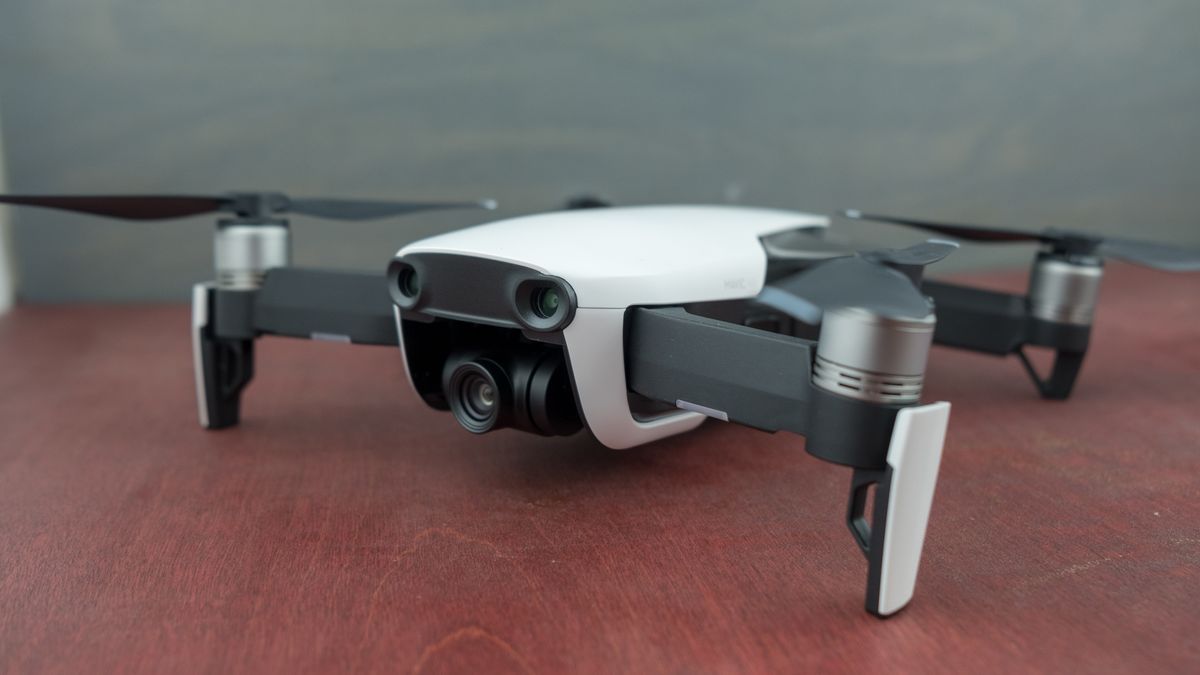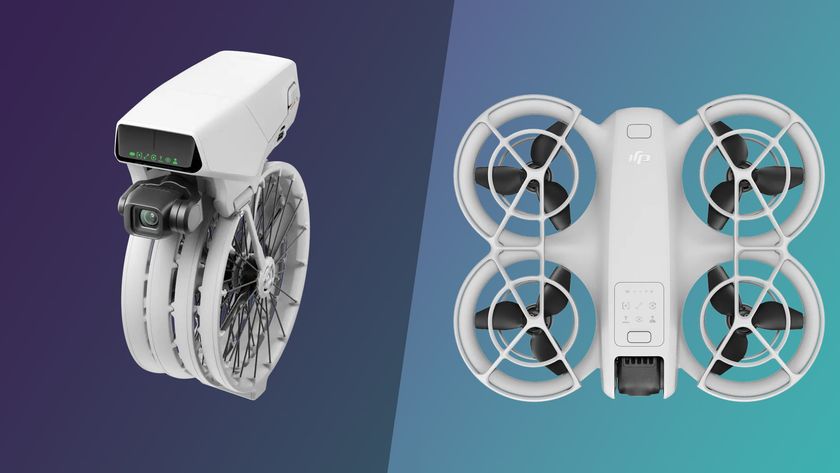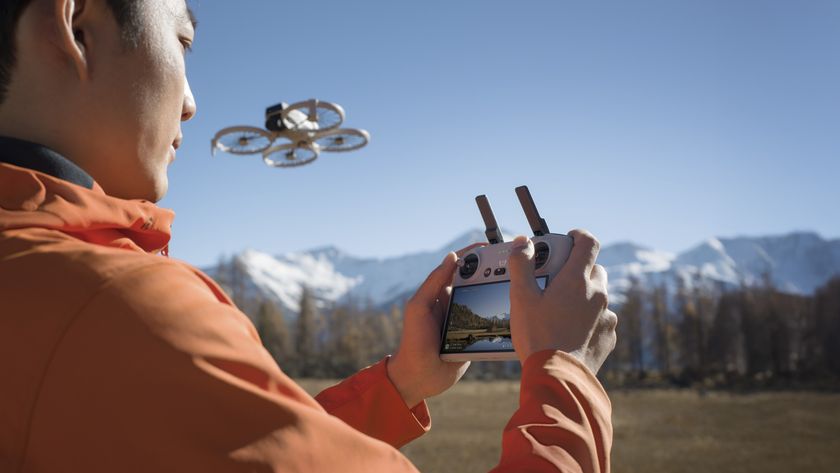TechRadar Verdict
A small drone with huge ambitions, the DJI Mavic Air packs 4K video recording, a three-axis gimbal, an upgraded obstacle avoidance system and onboard storage into a compact and foldable form factor that easily slips into a jacket pocket. You’d be hard pressed to find a better drone that packs up so neatly and has as many smarts as this one.
Pros
- +
Incredible portability
- +
4K video at up to 100Mbps; 12MP HDR stills
- +
Near-perfect obstacle avoidance
- +
8GB internal storage
Cons
- -
Slightly jerky gimbal controls
- -
Could have better range
- -
Need multiple batteries for a great flying experience
Why you can trust TechRadar
The DJI Mavic Air is the near-perfect love child of the very successful Mavic Pro and the compact and user-friendly Spark. It's a consumer drone that highlights DJI’s commitment to innovation.
By taking the tech and foldable rotor arms from the DJI Mavic Pro and the small form factor and playfulness of the Spark – and then improving on both – DJI has produced its best drone yet for consumers.
Update: DJI originally intended to launch an update to the Mavic – the Mavic 2 – on July 18, but has now pushed that date back. However, an image of the DJI Mavic 2 appeared online in July, followed by a leaked ad that showed two models of the new drone (Pro and Zoom), as well as a list of specifications. For the time being, the DJI Mavic Air is one of the best drones you can buy. Review continues below.
The Mavic Air hovers over that perfect middle ground, offering high-end specs at a lower price point than the Mavic Pro. It has just about every bell and whistle (though this drone certainly does hum) you could ask for, from 4K video and 32MP panoramic pictures to a 21-minute battery life.
More importantly, the DJI Mavic Air is easy to fly thanks to an improved object avoidance system and gesture controls, giving this drone more mainstream appeal.
Want to see the DJI Mavic Air in action? Watch our video review below!
Price and availability
- Available now
- $799 (£769, AU$1,299) for the drone and accessories
- $999 (£949, AU$1,599) for the Fly More Combo
- Comparison: Mavic Pro is $999 (£1,099, AU$1,599); Spark is $399 (£449, AU$649)
With a starting price of $799 / £769 / AU$1,299, the Mavic Air is cheaper than its bigger-in-all-ways Pro sibling. Paying this price gets you the drone, a battery, the proprietary charger, redesigned remote controller, a small carrying case, four propeller guards and two full sets of propellers.
Given most drones’ limited flight time, you might want to consider investing in multiple batteries if you want to enjoy the full experience of flying one. To get that out of the box with the Mavic Air, DJI’s offering up the Fly More Combo priced at $999 / £949 / AU$1,599. It bundles the drone, three batteries, a remote controller, a travel bag, two pairs of propeller guards, six pairs of propellers, a battery-to-power-bank adapter and battery charging hub.
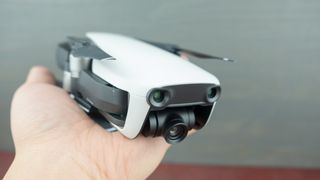
Even though the starting price is a high investment for a gadget with a 21-minute battery life, the upgraded tech housed within the sleek chassis makes the Mavic Air quite attractive, especially since it’s cheaper than its bigger brother. And, unlike the Spark, it ships with its own dedicated controller, which goes a long way to justifying the cost.
The Mavic Air is available via DJI’s online storefront and at major retailers.
Design and build
- Compact and foldable form factor returns
- Recessed gimbal adds protection, but the clip-on cover is awkward
- Removable joysticks on the redesigned controller
- USB-C port for data transfer only
The Mavic Air might resemble the Spark in terms of size, but that’s basically where the similarity ends. The new drone’s arms are foldable, like those of the Mavic Pro, taking portability to a whole new level.
When folded up, the Mavic Air can quite easily slip into a large pocket – think cargo pants or a big jacket. Weighing in at 430g, it’s heavier than the 300g Spark but lighter than the 743g Mavic Pro, and definitely lighter than a pint of beer.
The drone’s zip-up case reinforces how small it really is – it easily slips into a backpack or a camera bag with plenty of room to spare for the rest of the paraphernalia.

Despite looking like a toy, the Mavic Air is robust and well-built. The recessed gimbal, with its clip-on camera cover, adds a layer of protection, making this a great travel companion. However, popping the cover back on after use can be a tad fiddly, with no perfect way to clip it back on. You’ll just need to ensure the camera is facing straight ahead or you won’t get the cover aligned properly to slide into position.
Taking a page out of Spark’s design, DJI has launched the Mavic Air in three colors: white, black and red. Although the colors are a playful touch, we found that the red and black versions were fingerprint magnets. The white version looks the best, but it can become more easily lost at a distance against a bright sky.
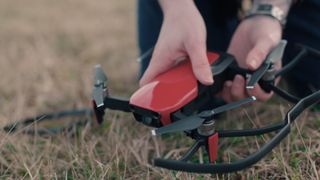
The Mavic Air is the first DJI drone to introduce USB-C for content transfer. Sadly, the USB port can’t be used to charge the drone. For that, you’ll need to lug around the proprietary charger.
Of course, it also comes with a microSD card slot, but this time there’s 8GB of onboard storage as well. So, if you forget to carry a card or manage to fill it up real quick, you can continue shooting with just a single tap.
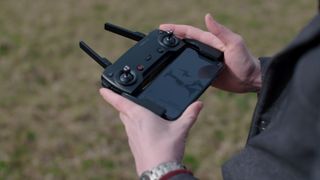
Another remarkable yet simple innovation that adds to the new drone’s portability is the redesigned remote controller. Out of the box, the joysticks for the controller are tucked neatly away under the foldable smartphone clips, giving the new controller a flat surface that allows it to slide into the pocket at the back of the drone’s case. Just remove and screw them on, then unscrew and stow away as you please.
The controller lacks the Mavic Pro remote’s built-in screen for flight telemetry, but squeeze your smartphone into the foldable clips and, viola, you have access to a live video feed and every other piece of piloting information that you need.
Performance and control
- Improved obstacle avoidance system
- Gesture controls
- Top speed of 68.4 km/h (40 mph)
- Maximum transmission distance of 4 km (2.5 miles) with controller; 50m with mobile device
Setting up the Mavic Air isn’t hard if you’ve used a DJI drone before. If you haven’t, you’ll need to install the DJI Go 4 app on your phone (available for Android or iOS) and then follow the steps on screen to connect to the drone, either directly via Wi-Fi or by linking to the controller. Once set up, flying the drone is smooth as butter.
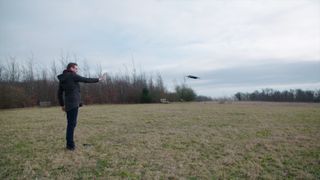
And it’s fast, or at least feels that way because of its diminutive size. In Sport mode, this pocket rocket can reach a maximum speed of 68.4 km/h, or 40 mph. At such speeds, however, if the camera is facing sideways, you’ll capture the front propellers whirring, which may not necessarily be what you want in your video. That said, this isn’t a problem unless you’re pushing the drone to its top speed.
Everyone, however, will experience the fact that the Air is loud compared to the much more expensive Mavic Pro Platinum with low-noise propellers. You’ll actually hear it before you see it when it’s just a small drone body in the distant sky.
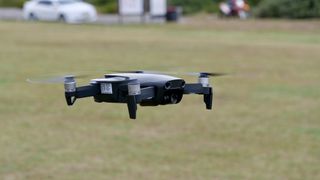
Novices don’t need to worry too much about the drone zipping around, either – the Mavic Air is harder to crash thanks to its seven-camera vision system and three-direction environmental sensing.
DJI’s brand-new Advance Pilot Assistance System (APAS) doesn’t just stop the drone in its tracks when it comes against an obstacle – it’ll chart an alternate route and continue flying safely. However, for the APAS system to work effectively, the drone needs to fly around and survey the location for a bit, picking up information to process from its surroundings. That’s the only prep work involved, but it’s automatically done by the drone.
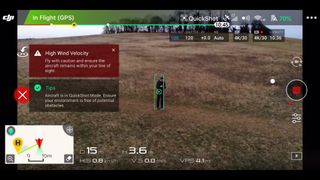
During testing, we flew our drone towards stone columns in an abandoned quarry and the Mavic Air smoothly flew over some and around others without us letting up on the controls.
That doesn’t mean the craft is completely crash-proof. There are no sensors on the top and sides, so there could still be a few close calls if you aren’t too careful.
You’d might expect that due to its small size and weight, the Mavic Air would have a hard time staying stable when hovering, but DJI promises it should be just fine in winds of up to 35 km/h (21.7 mph), and we were pleasantly surprised to find those claims seem to be accurate. Flying it by the seaside, when winds can pick up suddenly, the little craft remained remarkably stable in the air.
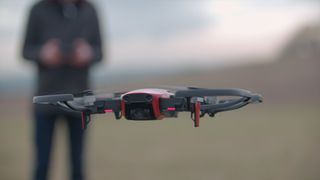
The transmission range for the Mavic Air is limited to 4 km/2.5 miles using the controller. That’s double the Spark’s 2 km/1.25 miles range, but a noticeably shorter than the 7 km/4.3 miles for the Pro. The reason? The Mavic Air relies solely on Wi-Fi instead of also using radio frequency (RF) to for its drone-to-controller connection.
This has had some people at the time of the drone’s announcement worried that the drone connection would suffer. We didn’t experience that in our testing of three different drones on three continents. But, if you’re planning on pushing the Mavic Air to its distance limits, you may experience some dropouts in the video feed.
Like the Pro, the Mavic Air features a three-axis gimbal, but it’s a redesigned one that makes this new drone much more stable. Although gimbal control while panning sideways is smooth, moving the camera up and down is still a tad jerky. To keep the footage as smooth as possible, it’s best to switch to Cinematic Mode on the app – designed to slow the drone down and reduce braking so video is smoother – but even this takes a lot of practice before you get a steady capture.

It’s also able to track up to 16 subjects at the same time. When using ActiveTrack, our DJI Mavic Air review unit was able to track six subjects standing within the frame individually. However, when switching to QuickShot mode, you’ll need them all together, or choose one individual as the focal point.
What made last year’s Spark a heck of a lot of fun to use was the addition of gesture controls. DJI has taken those smarts and improved on them, and also given the Mavic Air better SmartCapture functionality. Using your hands, you can make the bite-sized quadcopter land and take off from the ground, fly towards and away from you, or get it to follow you around as you move. Making a peace sign takes a still shot, while holding your thumbs and forefinger in a frame will begin and stop video capture.
What’s a lot more fun than SmartCapture (and great for sharing on social media) are the additional QuickShot modes – called Asteroid and Boomerang. Like the older QuickShot options available on both the Pro and Spark, Asteroid and Boomerang have preset flights paths that capture short videos with a subject as the focus, and work with just a few taps on the app, no composition required.
In the former, multiple shots are taken, then composed in-camera into a 10-second blip beginning with the subject and ending in a spherical bird’s-eye view of the locale. In Boomerang, the drone pans around the subject, then returns to its original point after a 360-degree circuit.
- 1
- 2
Current page: Introduction, price, design and performance
Next Page Image quality, battery life and verdict
While she's happiest with a camera in her hand, Sharmishta's main priority is being TechRadar's APAC Managing Editor, looking after the day-to-day functioning of the Australian, New Zealand and Singapore editions of the site, steering everything from news and reviews to ecommerce content like deals and coupon codes. While she loves reviewing cameras and lenses when she can, she's also an avid reader and has become quite the expert on ereaders and E Ink writing tablets, having appeared on Singaporean radio to talk about these underrated devices. Other than her duties at TechRadar, she's also the Managing Editor of the Australian edition of Digital Camera World, and writes for Tom's Guide and T3.
Most Popular


